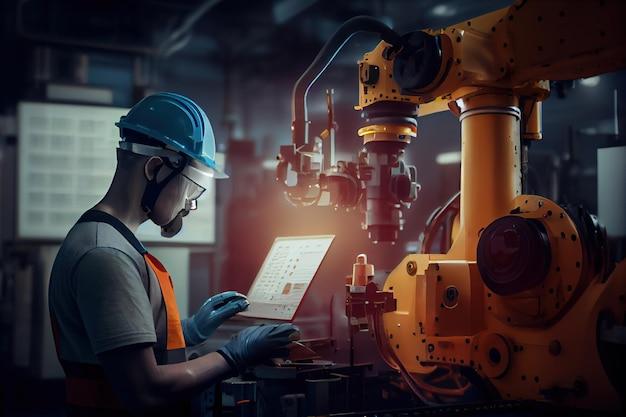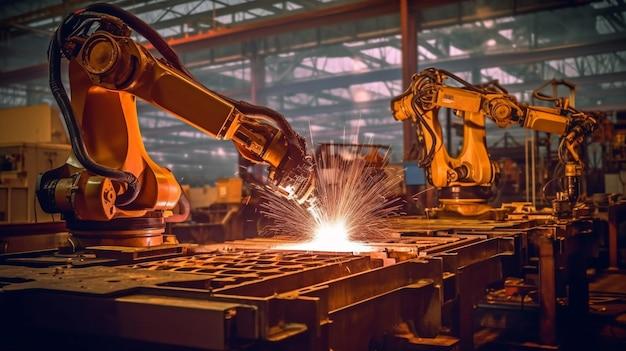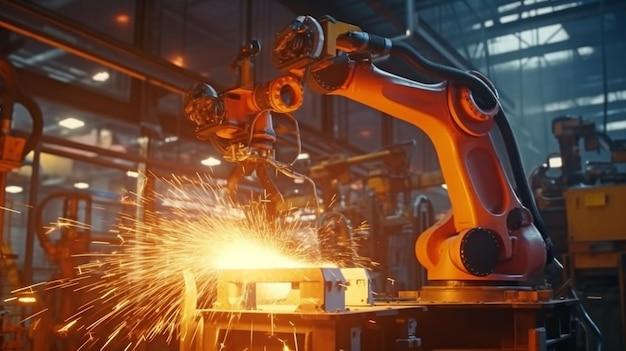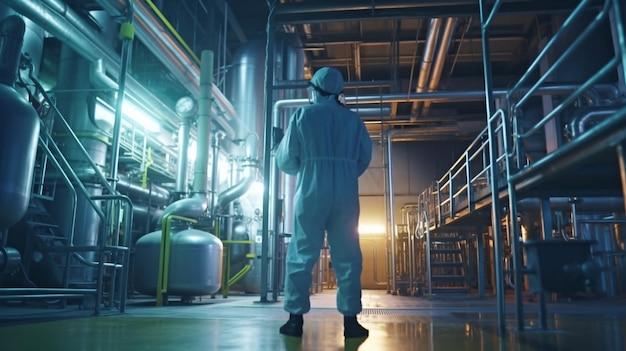Artificial intelligence (AI) has been revolutionizing various industries, and now it’s transforming the world of manufacturing. The integration of generative AI in the manufacturing process has opened up new possibilities and streamlined operations in ways we couldn’t have imagined before. From automotive design to the manufacturing process itself, generative AI is taking center stage. In this blog post, we will explore what generative manufacturing is, its use cases, and how it is shaping the future of the industry. So, let’s dive into the fascinating world of generative AI in manufacturing!
Generative AI Manufacturing: Revolutionizing the Production Process
Enhancing Efficiency and Innovation with Generative AI
Generative AI manufacturing is transforming the way products are designed and produced, bringing efficiency and innovation to the production process. By harnessing the power of artificial intelligence, manufacturers are now able to generate design options that were previously unimaginable. This groundbreaking technology allows for faster prototyping, cost savings, and increased product quality.
The Power of AI in Product Optimization
With generative AI, manufacturers can optimize product designs by considering a multitude of variables simultaneously. By inputting specific design criteria and constraints, the algorithm can generate countless design options. These options are not only aesthetically pleasing but also take into account manufacturing requirements like material strength, weight, and cost.
The ability to explore a vast design space quickly allows manufacturers to identify the best design solutions, leading to improved product performance and functionality. With generative AI, manufacturers can push the boundaries of innovation, creating products that were previously unachievable.
Streamlining the Design Process
Generative AI also streamlines the design process by automating mundane and time-consuming tasks. Traditionally, engineers would spend hours manually creating and iterating designs. With generative AI, the algorithm does the heavy lifting, rapidly creating design options that meet the desired objectives.
This automation frees up time for engineers to focus on more creative aspects of the design and allows for quicker iteration cycles. By accelerating the design process, manufacturers can reduce time to market, stay ahead of competitors, and adapt quickly to changing customer demands.
Reducing Costs and Waste
Generative AI is not just about improving design aesthetics; it also has a significant impact on cost reduction and waste minimization. By optimizing designs for material usage and manufacturability, manufacturers can lower production costs and minimize material waste.
The algorithm takes into account factors like the number of parts, assembly complexity, and potential manufacturing constraints. This optimization can lead to substantial savings in material costs and more efficient production processes, contributing to a greener and more sustainable manufacturing industry.
Empowering Collaborative Design
Generative AI is not limited to individual designers or engineers. It empowers collaborative design by allowing multiple stakeholders to contribute to the design process. With generative AI, designers, engineers, and even customers can input their preferences and constraints, collectively generating designs that meet everyone’s needs.
This collaborative approach fosters innovation and brings diverse perspectives to the table, resulting in unique and remarkable product designs. Generative AI expands the creative possibilities by breaking down silos and encouraging interdisciplinary collaboration within the manufacturing industry.
In conclusion, generative AI manufacturing is revolutionizing the production process, enhancing efficiency, and driving innovation. With its ability to optimize designs, streamline processes, reduce costs, and empower collaborative design, generative AI is transforming the way products are made. Embracing this technology is not only beneficial for manufacturers but also for consumers who can expect a new wave of innovative and sustainable products.
Generative AI Automotive: Revolutionizing the Future of Car Manufacturing
The Rise of Generative AI in the Automotive Industry
Generative AI, a branch of artificial intelligence, is making significant strides in revolutionizing the automotive industry. Through the application of innovative algorithms, generative AI is transforming the way cars are designed and manufactured. This subsection explores the exciting advancements and potential of generative AI in the automotive sector.
Designing Cars Like Never Before
Generative AI is enabling car manufacturers to push the boundaries of design like never before. With the ability to analyze enormous amounts of data, generative AI algorithms can generate countless design options based on specific parameters and constraints. By leveraging the power of generative AI, automakers can effortlessly explore a vast range of designs, leading to more innovative and visually stunning cars.
Enhancing Safety Features
Another area where generative AI is making a significant impact is in enhancing the safety features of automobiles. By analyzing real-world data on accidents and near-misses, generative AI algorithms can identify patterns and create simulations to predict potential safety risks. This allows manufacturers to develop advanced safety systems that can effectively mitigate potential dangers on the road.
Optimizing Manufacturing Processes
Generative AI is also streamlining and optimizing the manufacturing processes in the automotive industry. By analyzing data from the various stages of manufacturing, such as assembly line efficiency and material usage, generative AI algorithms can identify bottlenecks and suggest improvements to increase productivity and minimize waste. This not only saves time and resources but also improves the overall quality of the final product.
Revolutionizing Vehicle Customization
Traditionally, vehicle customization has been limited to a few options offered by car manufacturers. However, with generative AI, the possibilities for customization are virtually limitless. By collecting and analyzing customer preferences, generative AI algorithms can create unique and personalized car designs tailored to individual tastes. This level of customization not only enhances customer satisfaction but also opens up new avenues for revenue generation.
The Road to Autonomous Vehicles
Generative AI is a key player in the development of autonomous vehicles. By analyzing vast amounts of data collected from sensors and cameras, generative AI algorithms can create highly accurate models of the vehicle’s environment. This enables autonomous vehicles to make informed decisions and navigate complex road scenarios with precision and safety.
With generative AI driving innovations in design, safety, manufacturing, customization, and autonomy, the automotive industry is on the verge of incredible transformation. The future of car manufacturing will undoubtedly be shaped by the revolutionary capabilities of generative AI, ultimately leading to safer, more efficient, and personalized vehicles for us all to enjoy.
Generative Manufacturing Process
Understanding the Magic
In the realm of manufacturing, there exists a fascinating process that blends the best of technology and creativity. Say hello to Generative Manufacturing! This innovative approach takes traditional manufacturing to a whole new level, harnessing the power of Artificial Intelligence (AI) to conjure up remarkable designs and optimize materials, resulting in more efficient production processes.
Deconstructing the Enigma
The Generative Manufacturing process incorporates three key elements: AI, design, and production. By utilizing complex algorithms, AI identifies the optimum parameters for a given product based on user-defined inputs. It then creates a multitude of potential designs, evaluating and refining them until the perfect one emerges.
The Dance of Ideas
Through this process, Generative Manufacturing encourages a unique collaboration between human designers and AI. Designers no longer work in isolation; they become partners with AI, leveraging its computational prowess to explore uncharted territories. Together, they embark on a dance of ideas, continuously evolving and enhancing designs to push the boundaries of what’s possible.
Beauty in Efficiency
Generative Manufacturing is not only about pushing creative boundaries. It also excels at optimizing production resources. By using AI to analyze factors such as material usage, weight distribution, and structural integrity, the process uncovers the most efficient way to bring a product into existence. This not only saves time and money but also contributes to sustainability efforts by reducing waste.
Taking Inspiration from Nature
Nature has always been the ultimate design maven, and Generative Manufacturing recognizes and embraces this. Through the use of AI algorithms inspired by biological processes such as evolution and genetic algorithms, this manufacturing process taps into the brilliance of nature’s design, resulting in organic and intricate geometries that may seem almost otherworldly.
Mastery in Complexity
The beauty of Generative Manufacturing lies not only in its ability to create stunning designs but also in its mastery of complexity. Harnessing the power of AI, it efficiently generates intricate shapes and structures that would be impossible or impractical to produce using traditional methods. This opens up a world of possibilities for industries such as aerospace, automotive, and even fashion.
In conclusion, Generative Manufacturing process represents a fascinating fusion of human creativity and AI-powered innovation. It empowers designers to push their limits, optimize production resources, and unlock new realms of intricacy and complexity. By understanding and embracing this magical process, we can shape a future where imagination knows no bounds.
What is Generative Manufacturing
Understanding the Basics
Generative manufacturing might sound like a complex term, but fear not! Let’s break it down into something we can all understand. It’s all about harnessing the power of Artificial Intelligence (AI) to revolutionize manufacturing processes. Just think of it as AI’s way of lending a helping hand to the good old factory floor.
The AI Guru Overseeing the Shop Floor
In generative manufacturing, AI takes the lead and becomes the almighty guru of the shop floor. It uses advanced algorithms and data analysis to optimize product designs, production workflows, and even material usage.
How Does It Work?
Through the magic of generative manufacturing, AI utilizes vast amounts of data to generate multiple design options. Imagine giving AI a blank canvas and watching it unleash its creative prowess. These options are then evaluated based on specific criteria like strength, weight, and cost-effectiveness.
From Art to Reality
Once the optimal design is chosen from the AI-generated smorgasbord, it’s time for the magic to happen. The chosen design is brought to life using technologies like 3D printing, automated machining, or additive manufacturing. It’s a fascinating process that merges digital innovation with good old-fashioned craftsmanship.
The Benefits are Endless
Generative manufacturing offers a host of benefits. First and foremost, it optimizes the manufacturing process, saving time and money. With AI at the helm, companies can create products that are stronger, lighter, and more efficient. Plus, generative manufacturing allows for greater customization and flexibility, leading to happy customers and increased competitiveness.
Embracing the Future
Generative manufacturing is not just a passing trend; it’s the future of manufacturing! The possibilities are endless, and as AI continues to evolve, so too will the manufacturing landscape. So buckle up and get ready for a brave new world where AI and manufacturing join forces to create amazing things!
Now that we’ve demystified generative manufacturing, it’s time to dig even deeper. In the next subsection, we’ll explore the fascinating realm of AI’s role in design optimization. Get ready to have your mind blown!
Generative AI Manufacturing Use Cases
1. Enhancing Product Design
Generative AI manufacturing has revolutionized product design by allowing manufacturers to explore and create innovative designs quickly and efficiently. With the help of machine learning algorithms, manufacturers can input various parameters and constraints, such as materials, cost, and performance requirements, and generate a multitude of design options. This not only saves time but also enables the creation of unique and optimized products that may not have been possible through traditional design methods.
2. Streamlining Production Processes
By employing generative AI in manufacturing, companies are able to streamline their production processes and improve efficiency. Through analysis of large sets of production data, AI systems can identify patterns and make real-time optimizations that can enhance productivity and minimize waste. This includes optimizing machine settings, adjusting production schedules, and predicting maintenance needs, resulting in cost savings and increased output.
3. Quality Assurance and Inspection
Generative AI is being applied in manufacturing to improve quality assurance and inspection processes. By analyzing data from various sensors and cameras, AI algorithms can identify defects or anomalies in real-time, ensuring that products meet the required standards. This not only reduces the need for manual inspection but also prevents defective products from reaching the market, avoiding potential recalls and customer dissatisfaction.
4. Supply Chain Optimization
Generative AI technologies are also transforming the supply chain in manufacturing. By analyzing data from multiple sources, including suppliers, transportation networks, and customer demand patterns, AI algorithms can optimize inventory levels, predict disruptions, and recommend the most efficient routes for delivery. This improves overall supply chain efficiency, reduces costs, and enhances customer satisfaction.
5. Predictive Maintenance
One of the most valuable applications of generative AI in manufacturing is predictive maintenance. By constantly monitoring machines and equipment, AI algorithms can identify precursors to failure and predict when maintenance will be required. This enables manufacturers to proactively schedule maintenance activities, minimizing unexpected breakdowns and downtime. As a result, manufacturers can reduce costs, extend the lifespan of machinery, and optimize production schedules.
Generative AI is revolutionizing the manufacturing industry by offering a range of applications and use cases that enhance product design, streamline production processes, improve quality assurance, optimize the supply chain, and enable predictive maintenance. As AI technology continues to evolve, we can expect even more innovative applications in the future. It is clear that generative AI is transforming the manufacturing landscape, improving efficiency, productivity, and ultimately, the bottom line.
How Can Generative AI Be Used in Manufacturing
Artificial Intelligence (AI) has made significant advancements in recent years, and one area where it is gaining attention is manufacturing. Generative AI, in particular, holds great promise in revolutionizing manufacturing processes and optimizing production. Let’s delve into how generative AI can be used in manufacturing and the benefits it brings to the table.
Enhancing Product Design and Optimization
Generative AI can aid in the creation of innovative and efficient product designs. By inputting specific parameters and constraints, the AI algorithm can generate numerous design options, taking into account various factors like cost, materials, and functionality. Engineers can then analyze these options and select the most viable design, ultimately saving valuable time and resources.
Streamlining Supply Chain Management
Efficient supply chain management is crucial for manufacturing success, and generative AI can play a vital role in this area. By harnessing AI’s data processing capabilities, manufacturers can optimize their supply chain by accurately predicting demand, managing inventory levels, and identifying potential bottlenecks. This helps minimize costs, streamline operations, and improve overall efficiency.
Predictive Maintenance to Minimize Downtime
Machine breakdowns and unplanned maintenance can disrupt manufacturing operations and lead to costly downtime. Generative AI can be employed to analyze real-time data from sensors, equipment, and historical records to predict potential machine failures. By detecting patterns and anomalies, AI algorithms can alert operators in advance, allowing for proactive maintenance and minimizing unexpected downtime.
Quality Control and Defect Detection
Maintaining high product quality is essential for manufacturing, and generative AI can assist in achieving this goal. By analyzing large amounts of data, AI algorithms can quickly identify patterns and anomalies that may indicate defects or quality issues. This enables manufacturers to take immediate corrective actions, preventing flawed products from reaching the market and safeguarding their reputation.
Process Optimization and Efficiency
Generative AI can also optimize manufacturing processes, leading to increased efficiency and productivity. By analyzing data from various sources such as production lines, employee performance, and equipment utilization, AI algorithms can identify areas for improvement. Manufacturers can then implement strategic changes to streamline operations, reduce waste, and increase overall productivity levels.
Generative AI has the potential to transform the manufacturing industry, revolutionizing product design, supply chain management, maintenance practices, quality control, and process optimization. By harnessing the power of AI, manufacturers can enhance efficiency, minimize costs, and ultimately deliver better products to consumers. As technology continues to advance, it is an exciting time for the integration of generative AI in manufacturing, promising a future of innovative and sustainable production processes.
Artificial Intelligence in Design and Manufacturing
Artificial intelligence (AI) has revolutionized numerous industries, and design and manufacturing are no exception. The integration of AI into these fields has unlocked a world of possibilities, streamlining processes, boosting productivity, and fostering innovation. In this subsection, we’ll explore the ways in which AI is transforming the design and manufacturing landscape.
Enhancing Design Efficiency
AI has become an invaluable tool for designers, assisting them in various aspects of the design process. With AI-powered algorithms, designers can automate repetitive tasks, such as creating and iterating designs, optimizing parameters, and generating variations. This not only speeds up the design phase but also allows designers to explore more creative options.
Iterative Design with AI
Gone are the days of manually tweaking designs. AI algorithms can analyze data from previous iterations, identify patterns, and suggest improvements. This iterative design process not only saves time but also ensures that designs are continually optimized for efficiency and performance.
Optimizing Manufacturing Processes
AI is also making its mark in the manufacturing sector by optimizing processes and improving efficiency. Through the use of machine learning algorithms, AI can analyze vast amounts of data from sensors, machines, and production lines to identify patterns and anomalies. This enables manufacturers to predict and prevent potential issues, minimizing downtime and maximizing productivity.
Predictive Maintenance
By leveraging AI, manufacturers can implement predictive maintenance strategies. Machine learning models can analyze data on machine performance, identify signs of wear and tear, and predict when maintenance will be required. This enables manufacturers to schedule maintenance proactively, preventing costly breakdowns and reducing downtime.
Enabling Customization and Personalization
AI is empowering manufacturers to offer greater customization and personalization options to consumers. By utilizing AI algorithms, manufacturers can efficiently process customer data and tailor products to individual needs and preferences. This not only enhances customer satisfaction but also opens up new business opportunities.
Agile Manufacturing
With AI-powered systems, manufacturers can quickly adapt to changing market demands, trends, and customer preferences. By analyzing real-time data and consumer insights, AI can guide production lines to be more flexible, allowing for rapid customization and shorter time-to-market.
In conclusion, AI is revolutionizing the design and manufacturing industries, bringing newfound efficiency, optimization, and personalization. From enhancing design processes to optimizing manufacturing operations, AI-powered systems are reshaping these industries for the better. As technology continues to evolve, we can expect AI to play an increasingly important role in driving innovation and transforming the way we design and manufacture products.



